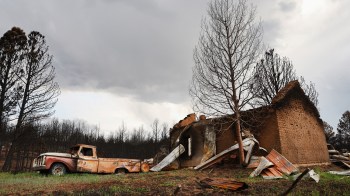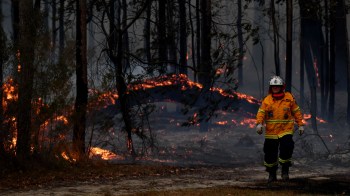Environmentalists, timber industry team up to fight wildfires
Environmentalists, timber industry team up to fight wildfires
Kai Ryssdal: Wildfires are still burning across big chunks of Arizona. That includes the Wallow Fire, which has so far ripped through more than 800 square miles of mountain terrain. The state’s biggest fire ever. These kinds of mega-fires are increasingly common across the West. It costs a lot of money to help protect forests before fire actually strikes. The question: Who will pay for it?
From KNAU in Flagstaff, Claudine LoMonaco looks at one potential solution.
Claudine LoMonaco: The trouble with the forests of Northern Arizona begins from the ground up.
Taylor McKinnon: The floor of this forest is composed of several inches of pine needles that have accumulated over a century. You have to work your way down before you even get to the soil.
That’s Taylor McKinnon, an environmentalist with the Center for Biological Diversity. He also points out the trees, 10 times as many as there should be. A century of suppressing natural fires created this overgrown forest. Now, when fire starts, the pine needles and smaller trees act as kindling, funneling flames up to the crowded treetops above. And then…
Pascal Berlioux: All of a sudden hell breaks loose.
That’s Pascal Berlioux. He stands beside McKinnon, pointing up to the towering Ponderosa Pines.
Pascal Berlioux: If you’re on a good wind, that fire is then going to jump from canopy to canopy and essentially destroys the entire place…
Spreading catastrophic fires for miles. It’s exactly what’s happening right now with the Wallow Fire, 150 miles southeast of here.
Berlioux is a French-born timber magnate. He and McKinnon, the environmentalist, make an unusual pair. But they’re part of a team of former enemies who’ve come together to save Northern Arizona’s forest before catastrophic fires burn it down. The project would thin the forest and restore its natural eco-system. That includes frequent, low burning grass fires. It would also create hundreds of long-term jobs, and get business to pay for it all.
That’s where Berlioux comes in.
Berlioux: You’d probably get rid of all this small diameter stuff here.
Berlioux’s plan is to let the big trees grow, but cut down the overcrowded small trees. He’ll turn that wood into what’s called Oriented Strand Board, or OSB. It’s like plywood made out of wood chips, and it’s a lucrative business. Which is a good thing. Officials plan to protect 2.4 million acres of forest. It’s the largest restoration project ever attempted, and could cost up to a billion dollars.
Berlioux: There is no way this money is coming from D.C. There is no way an increase of fishing or hunting licenses can pay for it. We have to design an economy that can pay for restoration. And that’s what we’re doing.
Conservation groups will guide the thinning and restoration. And the U.S. Forest Service will oversee the work. It’s taken years to build up the sprawling coalition of environmentalists, industry, and government. It’s even more remarkable given the personal history of those involved.
David Tenney: There was a time when I wouldn’t have given you a nickel to sit in the same room with some of the guys from the Center for Biological Diversity.
That’s Navaho County Supervisor David Tenney talking about McKinnon’s environmental group. In the 1800’s, Tenney’s great, great grandfather brought the first sawmill to Arizona. In the 1990’s, the Center for Biological Diversity destroyed the family business when it shut down Arizona’s logging industry to protect the Mexican Spotted Owl.
Tenney: And now, I not only sit in the same room with them, I consider them friends.
Tenney’s one of the project’s most vocal supporters. It’s something he could never have imagined 10 years ago. But that was before the 2002 Rodeo Chediski fire. It burned nearly a half a million acres and 400 homes. Thousands of people, including Tenney, were evacuated.
Tenney: The fire departments, when they would come into a subdivision that they knew was in danger, they would put a flag in the tree in front of your house. A green flag meant we can defend this property. A yellow flag meant we’ll try, but we don’t know what we can do. And I remember when we came back in that day, we came driving into the driveway and hanging in our oak tree, right in front of the house was a red flag. That’s when it hit home.
The fire convinced Tenney something needed to be done. But he wasn’t sure what until he met Pascal Berlioux. Berlioux had just moved to Flagstaff with his family when the Rodeo Chediski fire broke out. The fire got Berlioux thinking. Could an OSB plant save the forests that lured him here?
Taylor McKinnon says Berlioux won over environmentalists by opening his books to them.
McKinnon: And nobody’s ever done that before.
This project is a major shift for the U.S. forest service. Project head Henry Provencio says that for decades, the agency treated the forests like a commodity, valuing logging over conservation. Provencio it’s largely why the forests are in such bad shape today.
Henry Provencio: We often pay for the sins of our past. We pay for that in terms of public trust.
He says he hopes the project will restore that trust along with the forest. Work is scheduled to begin this fall.
In Flagstaff, I’m Claudine LoMonaco for Marketplace.
There’s a lot happening in the world. Through it all, Marketplace is here for you.
You rely on Marketplace to break down the world’s events and tell you how it affects you in a fact-based, approachable way. We rely on your financial support to keep making that possible.
Your donation today powers the independent journalism that you rely on. For just $5/month, you can help sustain Marketplace so we can keep reporting on the things that matter to you.


















